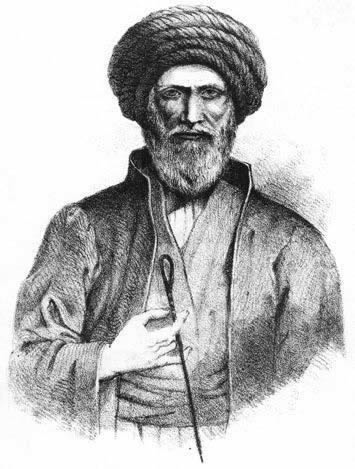Mar Auraham Shimun
 Mar Auraham Shimun was Patriarch during, arguably, the most transitional and challenging periods in the history of the Church of the East. His Patriarchate experienced the arrival of American and European missionaries to the Hakkari mountains, followed by a series of Turco-Kurdish led massacres beginning in 1843 that threatened the Assyrian Nation’s survival to a degree not seen since Tamerlane’s Mongul warriors forced them out of Mesopotamia in the late 14th century. More-so than any of his recent predecessors, Mar Auraham was compelled to balance his broad ecclesiastical responsibilities with increasingly challenging temporal duties that included settling tribal feuds and land disputes, collecting taxes, and authorizing military campaigns.
Mar Auraham Shimun was Patriarch during, arguably, the most transitional and challenging periods in the history of the Church of the East. His Patriarchate experienced the arrival of American and European missionaries to the Hakkari mountains, followed by a series of Turco-Kurdish led massacres beginning in 1843 that threatened the Assyrian Nation’s survival to a degree not seen since Tamerlane’s Mongul warriors forced them out of Mesopotamia in the late 14th century. More-so than any of his recent predecessors, Mar Auraham was compelled to balance his broad ecclesiastical responsibilities with increasingly challenging temporal duties that included settling tribal feuds and land disputes, collecting taxes, and authorizing military campaigns.
Born in approximately 1801 to Qasha Rowil d’Mar Shimun and his wife Khami, Mar Auraham is known to have had two paternal uncles named Marcos and Shlimun, and nine siblings (six brothers and three sisters). When his great-uncle, the former Patriarch Mar Yuna passed away around the year 1820, Mar Auraham was ordained patriarch. Some sources mention a man (possibly an older cousin) named Mokhattis with whom he temporarily shared the patriarchate in order to appease dissenting maliks, however Mokhattis died within two years, leaving Mar Auraham as sole Catholicos.
At this time European explorers in the region were exciting the imaginations of missionaries back home with rumors of mysterious mountain “Nestorians”; perhaps one of the “lost tribes of Israel.” In the mid-1830s, Justin Perkins and Dr. Asahel Grant, American Presbyterians, would be the first western missionaries to meet with Mar Shimun. They were soon followed by English Episcopalians, and French Dominicans. This sudden foreign attention alarmed the local Kurdish Moslem chieftains, as well as the Ottoman Government of Turkey. Increased Kurdish raids on Assyrian villages, including the burning down of the Patriarchal house in Qudshanis in 1841, perpetuated a dangerous cycle of mutual recrimination and bloodshed that culminated in a coordinated attack by the combined forces of Bedr Khan Beg and his brother-in-law, Nurallah Bey on Tyari in 1843, and Tkhuma in 1846.
Multiple thousands of Assyrians were massacred, their sheep stolen and villages ransacked. Mar Auraham’s aging mother Khami, his brother Zadoc, and Ishai, a young natur kursi (patriarchal candidate) were murdered. Among the many Assyrian notables who courageously sacrificed their lives in the desperate fighting was Mar Auraham’s brother-in-law, Malik Ismael of Chumba (Tyari). Miraculously, Mar Auraham managed to escape to the protection of the British Vice-Consul in Mosul, with whom he worked to negotiate the release of hundreds of Assyrian prisoners, including two of his own brothers and a sister.
Under pressure to submit to the authority of the Ottoman Government, Mar Auraham managed to keep both Church and millet intact by refusing to relinquish patriarchal authority over the Ashirets (independent tribes). Additionally, he declined large sums of money offered by the Catholics to submit to the Pope. Within three years, Mar Auraham would escape from his forced detention in Mosul, fleeing to the American missionaries in Urmia, before temporarily residing in nearby Khosrawa, and returning the Patriarchal See to Qudshanis in 1849.
In welcoming missionary assistance, Mar Auraham envisioned new educational opportunities for the children and priesthood, access to western medicine and markets, a printing press for the Church, and above all, permanent political and military protections for the Assyrian millet. Having little to no foreign affairs experience to draw from, Mar Auraham attempted the near-impossible political balancing act of managing the competing attentions of American, English, and French missionaries, whilst defending against the increased antagonism and hostilities of neighboring Muslim Kurdish tribes, negotiating with powerful Turkish, Persian, and Russian officials, and appeasing the conflicting demands of the Ashiret maliks; all while faithfully executing his ecclesiastical commission to keep Church and cultural customs whole and intact.
His Holiness Mar Auraham, deeply exhausted and sorely tried from his ceaseless efforts to shepherd the Assyrian millet and Church of the East through one its most trying periods, died in the spring of 1860 at 59 years old while residing in his mountain retreat at Diz as Turkish tax-collectors pursued him. He was interred among the former patriarchs at Mar Shalita in Qudshanis. Rowil, his eighteen year old nephew, son of Benyamin and Surma (Mar Auraham’s brother and sister-in-law), succeeded him as Mar Shimun, Catholicos XX, Patriarch of the Church of the East.
